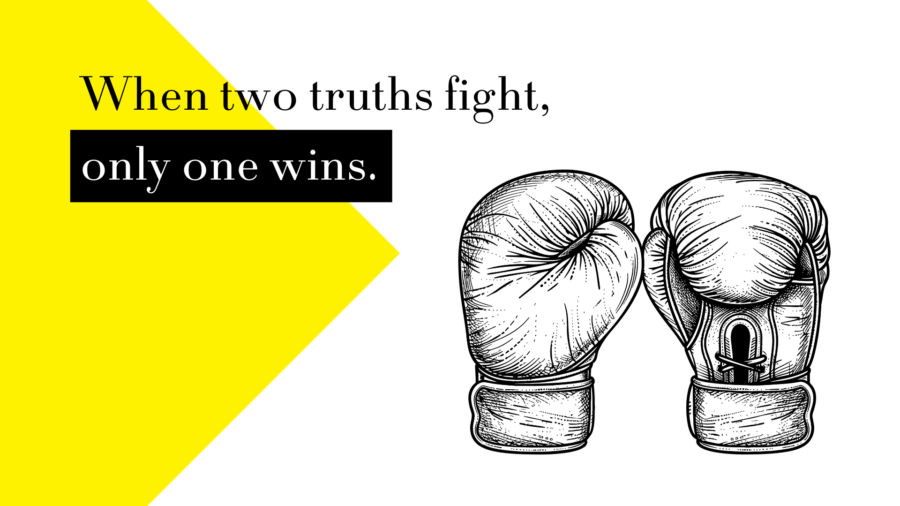All change involves choice.
Sometimes, that choice is between two things someone deeply believes or values. That kind of choice creates a specific form of mental pain: cognitive dissonance.
Cognitive dissonance is the discomfort someone feels when conflicting beliefs or desires challenge their current understanding of the world—when the Ding! of truth makes their previous perspective feel out of tune with what they want or who they want to be.
Cognitive dissonance is also incredibly powerful. As soon as someone feels the discomfort a conflict of truths creates, their brain will quickly choose one of them to make the discomfort disappear.
When two truths fight, only one wins.
Aristotle understood this concept, although he called it by another name, “anagnorisis”—a moment of critical discovery or recognition. For the philosopher, that dissonance-creating moment was essential to structuring every story of transformation.
For anyone trying to inspire change, it’s also essential to the stories people tell themselves.
Cognitive dissonance is our modern-day anagnorisis—the moment someone confronts their beliefs and must choose between them. But the moment usually happens so quickly that the choice is neither conscious nor rational. People make decisions based on what feels most right in the moment, which in reality is what feels most in line with the identity they aspire to and the principles that set the patterns of their behavior.
Because cognitive dissonance is the mental spark that turns contemplation into action, creating it is a requirement for instigating long-term change.
That may seem to violate another of the principles of lasting change, where pain is the enemy, but this is one of the few scenarios where pain is, indeed, your ally. That’s because the pain of cognitive dissonance is like a pinprick—sharp but fleeting. Once a person decides and resolves the dissonance, the pain dissolves. What’s more, the pain of cognitive dissonance and the decision that resolves it don’t erode someone’s identity, they clarify it.
IN OTHER WORDS…Change requires choice. In a battle of beliefs, the strongest source of self survives.
F. Scott Fitzgerald once noted, “The test of a first-rate intelligence is the ability to hold two opposing ideas in mind at the same time and still retain the ability to function.” That’s true, as long as the two ideas are kept fairly far apart from one another. But when put head-to-head, one idea is inevitably stronger.
One of the best examples of this at the market level is the De Beers “A Diamond is Forever” campaign from 1947.
Prior to De Beers’s new slogan, a simple metal ring was considered the ultimate symbol of “forever” for married couples—a circle, with no beginning and no end. However, when the brand aligned diamond rings with the idea of an endless commitment, they created cognitive dissonance. The conflict wasn’t just choosing between two types of rings. It was also about the degree of “forever” the choice would represent and the conflict of beliefs and values that ensued.
History tells us which idea won. For many couples, a diamond is still the best symbol of forever.
That doesn’t mean resolving dissonance is easy.
The more two ideas represent someone’s deepest desires and values, the more difficult the choice between them can be.
In her TED talk, philosopher and professor Dr. Ruth Chang suggests that what someone decides in these moments says less about the options and more about the person themselves. But it’s through these tough choices that someone can exercise their agency and determine what they value most.
This is why understanding, and carefully creating, cognitive dissonance is so crucial: change doesn’t happen without it.
The art of using cognitive dissonance successfully, however, lies in framing your argument’s assumptions in a way that naturally aligns the desired change with someone’s deeper values and identity. Rather than forcing a change, your framing helps people see which choice truly resonates most with who they are. In the end, it’s these value-driven choices that create long-term changes that stick.
P.S. Guess what?! What you just read was an excerpt of my new book, Say What They Can’t Unhear that just came out! This book explores more in-depth my nine “persuasion proverbs,” that are easy to remember, simple to implement, and will give you the tools to transform any audience of lukewarm prospects into passionate believers.
